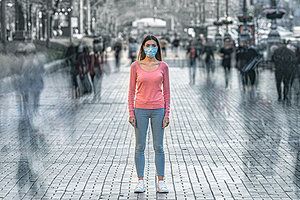Some doctors thrive in a personality-based clinic and have a loyal following no matter what services or equipment they offer, but for most chiropractic offices who are trying to grow and expand, new equipment purchases help us stay relevant and continue to service our client base in the best, most up-to-date manner possible. So, regarding equipment purchasing: should you lease, get a bank loan, or pay cash?
The Cost of Slowing the COVID Spread: Help Quantify the Consequences
Editor's Note: The following open letter to the profession, which includes a request to participate in a short survey, was submitted by Devin Brossard, DC.
The spread of COVID-19 was slowed ... but at what cost? Since the beginning of 2020, the persistent justification for the COVID-19 pandemic response has been, "We just don't know enough." In order to have time to gain information, mandates were implemented and claimed to be "not that bad."
Coming up on the two-year anniversary of the pandemic, two questions must be answered:
- What do we know now?
- How do we quantify "not that bad?"
Data dictates decisions, and therefore the lack of data has led to indecision in responses from elected officials. The goal is to gain more data and make better decisions moving forward.
In our clinic, we have been gathering data in order to improve our patient care, while also respecting our patients' choices and values. We have seen more than 86,000 patient visits since the beginning of 2020. By March 2020, stay-at-home orders, social distancing and mask use were in place, and we began observing a few measurable trends. These trends included an increase in injuries with minimal or no provocation; and an increase in new conditions such as vertigo, headaches, dizziness, TMJ dysfunction, weight gain, clinically low levels of blood oxygen, and reported psychological difficulties such as suicidal thoughts, anxiety and depression in both children and adults.

With those patients who chose regular chiropractic care, we were also able to witness the restoration of health with proper treatment frequency.
We noticed these trends exhibited in both patients who had contracted COVID-19 and those who had not. The data suggests mandates may have had a negative health consequence, and that more information needs to be gathered.
The spread was slowed, and COVID-19 is now becoming accepted as one of the viruses within our ecosystem. But now, two years into the pandemic, many people are suffering from fatigue, brain fog, chest tightness, rapid heart rate, and joint pain. This condition is known as long-haul COVID or long COVID, and is attributed to the lasting effects of contracting and recovering from COVID-19. Recovery from this condition will justifiably be the main focus post-pandemic.
The National Institutes of Health is offering $1 billion in grants to research treatment for long COVID. The chiropractic profession has a chance to help direct that money toward natural health care. This is the purpose of a national survey to objectively measure the effects of the pandemic, including those caused by the COVID-19 virus; stress related to mandates and mask use; and what health care strategies people have been using.
The stats are intriguing thus far. Of those surveyed, 83 percent of people have long-haul symptoms "directly related to stress"; 73 percent have long-haul symptoms from mask use; but very few have reported receiving chiropractic care. If the goal is recovery from the symptoms attributed to COVID long haulers, then we need to understand exactly what is inhibiting their healing process, discontinue those activities, and get patients under regular, frequent chiropractic care urgently.
The time for massive action is now. The chiropractic profession has known that this approach was not going to be effective from the beginning. Now we need to gain as much data as possible so we can affect policy to ensure mandates that negatively impact people's health are discontinued, and funding can be allocated to give everyone access to chiropractic care, regardless of financial status.
"Not that bad" doesn't mean good, and our children deserve better from health care. Take the two-minute survey at DontKnowEnough.com/surveys so we can gather more data and help officials make better decisions.
We're looking to gather as much data as possible from chiropractic patients, so please ask your patients to complete the survey as well. They can fill it out online while they wait in your reception area. Please get involved in collecting this important data by asking your patients to join the effort. Thank you.



